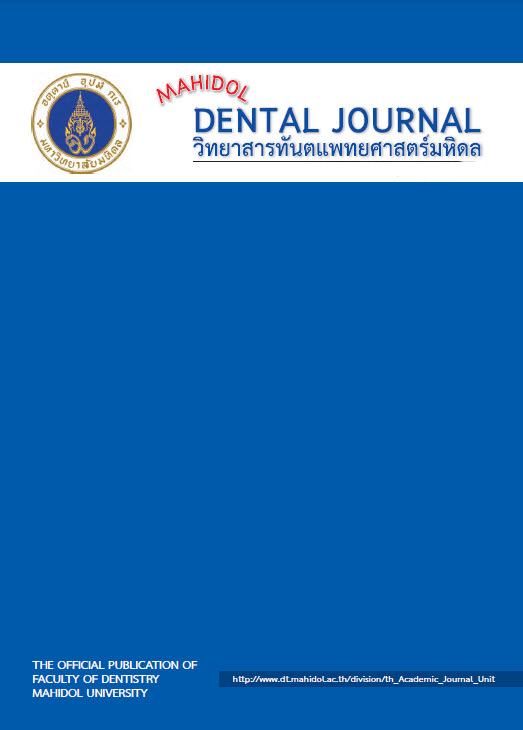Curing process modification of a ‘self-cured’ injection molding material: Effect on water sorption and solubility
Main Article Content
Abstract
Objectives: to determine water sorption and solubility of ‘self-cured’ IvoBase® Hybrid material in 2 curing
techniques and immersion times in water, and to compare them to ‘heat-cured’ SR Ivocap® High Impact material.
Materials and Methods: disc shaped (50 mm diameter and 0.5 mm thickness) of SR Ivocap® High Impact was cured in water at 100°C for 35 minutes, then at 25°C for 30 minutes (Ivocap wet curing). IvoBase®
system was either processed via the IvoBase injection machine programme at 120°C (IvoBase dry curing) or cured by the same method as SR Ivocap® (IvoBase wet curing). The specimens were kept in the desiccator containing freshly dried silica gel, weighed daily until their mass (m1) was constant to 0.2 mg and, the volume (V) were recorded. The conditioned specimens were immersed in distilled water for 7 days and 30 days. The specimen weight (m2) were recorded after removal from the water. The specimens were reconditioned to constant mass (m3) in the desiccator. Then water sorption (wsp) and water solubility (wsl) at 7 days and 30 days were calculated. Two-way ANOVA was used to analyze the data.
Results: water sorption of Ivocap wet curing, IvoBase dry curing and IvoBase wet curing were 20.8±0.5,
22.4±0.9 and 23.2±0.3 µg/mm3 respectively for 7 days immersion and 21.8±0.9, 22.6±1.1 and 23.9±0.1 µg/mm3 respectively for 30 days immersion. The water solubility were 0.83±0.01, 0.33±0.04 and 0.69±0.03 µg/mm3 respectively for 7 days immersion and 0.89±0.05, 0.62±0.08 and 0.65±0.02 µg/mm3 respectively for 30 days immersion. Water sorption of IvoBase material was significantly higher than that of Ivocap at 7 days and 30 days (p<0.05). On the contrary, water solubility of Ivocap material was significantly higher than that of IvoBase (p<0.05). While the 2 methods of curing IvoBase did not affect the material water sorption but water solubility at 7 days water storage of IvoBase cured at 100o C was significantly higher than the material cured via the automated instrument. All the specimens passed the ISO 20795-1 requirement for water sorption not exceeding 32 µg/mm3 and water solubility not exceeding 1.6 µg/mm3.
Conclusion: Water sorption of IvoBase material was significantly higher than that of Ivocap but water solubility of Ivocap material was significantly higher than that of IvoBase. The methods of curing IvoBase did not affect the material water sorption but these had an influence on water solubility significantly.
Article Details
References
References
Gladwin MA, Bagby MD. Clinical aspects of dental materials: theory, practice, and cases. 2nd ed. Baltimore: Lippincott Williams & Wilkins; 2004.
Craig RG, Powers JM, Wataha JC. Dental Materials-: Properties and Manipulation. 8th ed. St. Louis: Mosby; 2004.
Darvell BW. Materials Science for Dentistry. 9th ed. Cambridge: CRC Press; 2009.
Fischer K. Scientific Documentation IvoBase®. Available from https://downloads.ivoclarvivadent.com/zoolu-website/media/document/14373/IvoBase . Online June 2012.
McCabe JF, Walls AWG. Applied dental materials. 9th ed. Oxford: Wiley-Blackwell; 2008.
Phoenix RD, Mansueto MA, Ackerman NA, Jones RE. Evaluation of mechanical and thermal properties of commonly used denture base resins. J Prosthodont 2004; 13:17-27.
Anusavice KJ, Shen C, Rawls HR. Phillips' science of dental materials. 11th ed. St. Louis: Elsevier Health Sciences; 2007.
Chow TW, Cheng YY, Ladizesky NH. Polyethylene fibre reinforced poly(methylmethacrylate)--water sorption and dimensional changes during immersion. J Dent 1993; 21: 367-72.
Jang DE, Lee JY, Jang HS, Lee JJ, Son MK. Color stability, water sorption and cytotoxicity of thermoplastic acrylic resin for non metal clasp denture. J Adv Prosthodont 2015; 7: 278-87.
Ristic B, Carr L. Water sorption by denture acrylic resin and consequent changes in vertical dimension. J Prosthet Dent 1987; 58: 689-93.
Devlin H, Kaushik P. The effect of water absorption on acrylic surface properties. J Prosthodont 2005; 14: 233-8.
Tuna SH, Keyf F, Gumus HO, Uzun C. The evaluation of water sorption/solubility on various acrylic resins. Eur J Dent 2008; 2: 191-7.
Dogan A, Bek B, Cevik NN, Usanmaz A. The effect of preparation conditions of acrylic denture base materials on the level of residual monomer, mechanical properties and water absorption. J Dent 1995; 23: 313-8.
Gohlke-Wehrsse HL, Giese-Kraft K, Wostmann B. Clinical performance of a light-cured denture base material compared to polymethylmethacrylate--a randomized clinical study. Clin Oral Investig 2012; 16: 969-75.
Jagger R. Effect of the curing cycle on some properties of a polymethylmethacrylate denture base material. J Oral Rehabil 1978; 5:151-57.
Vallittu PK, Ruyter IE, Buykuilmaz S. Effect of polymerization temperature and time on the residual monomer content of denture base polymers. Eur J Oral Sci 1998; 106: 588-93.
International Organization for Standardization. ISO 20795-1 Dentistry-Base polymers Part 1: Denture base polymers. Geneva, Switzerland ; 2013.
Akin H, Tugut F, Polat ZA. In vitro comparison of the cytotoxicity and water sorption of two different denture base systems. J Prosthodont 2015; 24:152-5.
Cucci AL, Vergani CE, Giampaolo ET, Afonso MC. Water sorption, solubility, and bond strength of two autopolymerizing acrylic resins and one heat-polymerizing acrylic resin. J Prosthet Dent 1998; 80: 434-8.
Shah J, Bulbule N, Kulkarni S, Shah R, Kakade D. Comparative evaluation of sorption, solubility and microhardness of heat cure polymethylmethacrylate denture base resin & flexible denture base resin. J Clin Diagn Res 2014; 8: ZF01-4.
Leon BL, Del Bel Cury AA, Rodrigues Garcia RC. Water sorption, solubility, and tensile bond strength of resilient denture lining materials polymerized by different methods after thermal cycling. J Prosthet Dent 2005; 93: 282-7.

